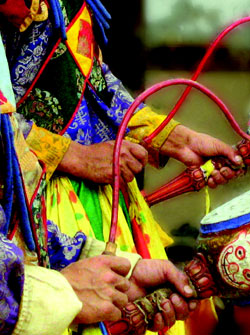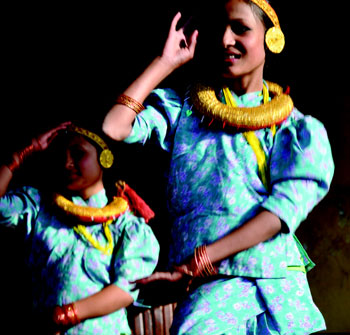Let’s face it—singing and dancing go together with “love and marriage like a horse and carriage.” I remember growing up and attending a lot of weddings. Invariably as the evening rolled on the band would get louder and louder and the music faster and faster. Eventually both young and old would be carried away with the festivities—and get out on the floor and dance.
This tradition is not only common here in the United States, but it spans the globe as well. I’ve sneaked a peek or two at weddings all over the world. The bride’s dress and/or the groom’s outfit may vary. The instruments probably take on different shapes and sounds, but as midnight approaches it seems as if everyone enjoys a dance. My most memorable eavesdropping on a wedding celebration occurred during anunforgettable night a number of years ago in Nepal.
You may recall from earlier stories that I was deeply involved in a start-up medical clinic in Nepal. My visits were not medically related, but rather I acted as a peace envoy between the headstrong western doctor who ran our clinic and the established government-controlled medicine men in Nepal. The two sides were in constant combat, it seemed, and I periodically went over to this remote country to smooth out the conflicts.
Our facilities were located in the city of Jorpati, about twenty kilometers from Kathmandu. Jorpati is just down the road from Bodha which houses the largest Buddhist Stupa in Nepal. This is a common tourist site, and I’m sure a number of you have visited there.
My visits usually lasted about two weeks, and my home for the duration of each stay was a relatively decent hotel called the Blue Star. Over the past few years the Blue Star has upgraded itself considerably, but at the time of my story it was not uncommon for a hotel employee to show up in my room about nine o’clock at night with a “flit” gun loaded with DDT. He would proceed to go around the baseboards of my room exterminating whatever bugs had dared to ventured in during the last twenty four hours.
My room was located on the second floor overlooking a courtyard filled with benches, tables and a slightly-raised platform. This area was used as an outdoor eating area, but it could also be rented for larger parties and gatherings. On my first-ever Saturday night in Nepal, I was privileged to look out over a most joyously-celebrated wedding ceremony.
True to form, after the dinner dishes from the wedding were cleared, a collection of stringed instruments accompanied by some percussion pieces arrived and began to entertain the guests. The noise kept me awake anyway, so I thought I might as well watch the goings-on below. It was an obviously joyous celebration with much laughter. The bride was a pretty little girl, no older than sixteen years I’m sure. She was dolled up fit-to-kill in a soft white dress which was loaded with multicolored shawls and a huge amount of colorful beads. Alas, the groom was in plain black with only a white Nehru shirt in contrast to his suit. I would guess most of you ladies would classify him as handsome—with his dark skin and black hair.
At just about midnight, a chant began to grow and grow, until the bride and groom in response to the chant got up on the stage to perform. They resisted a bit, but it was a foregone conclusion that they were going to lose. The performance began by the groom wrapping a rope around his bride’s waist, and, in a most aggressive fashion, he began to lead her around. He, the strong masculine type—she the weak and subservient bride following behind him. Slowly they began to circle the band which had now begun to play. The audience joined in with a resonant rhythmic clapping.
Around and around they went, but as they continued to circle, a change began to take place. Slowly but surely they were becoming equal—walking side by side. The rope was now binding them together more as partners. He was losing his bravado, and she became more of a participant as they circled the band.
The beat grew faster and the clapping louder The change of positions continued as they walked round and round. Now he was becoming the horse and she the driver. The rope began to act as a bridle for him and a means for her to steer him on—a complete reversal from the original positions in the dance. At this point the audience’s laughter and joking took over, and they all crowded around the couple, with glasses raised high in one huge delightful mass.
I will let you draw your own conclusions about the meaning of this ritual. I will only close by saying; perhaps they understand life better than I gave them credit for. As I am growing older and Barb and I are celebrating anniversary after anniversary, I am beginning to appreciate the significance of this traditional Nepali dance.
Harry Hubinger is a retired engineer who operated his own company for twenty years. He first began traveling outside the United States on business, but these visits escalated upon his retirement. He has now traveled to 115 countries and continues to add several new ones each year.
In 1998 he began writing his humorous and insightful articles for a supplement to a local newspaper. These stories, based on experiences most travelers could identify with, soon earned him a wide local following. In 2005 he published his first book, Stamps in My Passport—a collection of travel vignettes.
Harry has lived in Danville for almost forty years and has volunteered with the Danville Police Department for the past seven. His wife, Barbara, is the detail chronicler of their trips. Her journals provide the background for Harry’s broader view. You can get his book at: www.travelbookspub.com.

